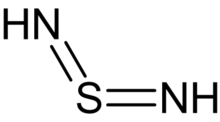Sulfur diimide

| |
| Names | |
|---|---|
| IUPAC name
diimino-λ4-sulfane
| |
| Other names
2λ4-Diazathia-1,2-diene
| |
| Identifiers | |
3D model (JSmol)
|
|
| ChemSpider | |
PubChem CID
|
|
| |
| |
| Properties | |
| H2N2S | |
| Molar mass | 62.09 g·mol−1 |
Except where otherwise noted, data are given for materials in their standard state (at 25 °C [77 °F], 100 kPa).
| |
Sulfur diimides are chemical compounds of the formula S(NR)2. Structurally, they are the diimine of sulfur dioxide. The parent member, S(NH)2, is of only theoretical interest. Other derivatives where R is an organic group are stable and useful reagents.
Organic derivatives
[edit]
A particularly stable derivative is di-t-butylsulfurdiimide.[1] It is prepared by reaction of tert-butylamine with sulfur dichloride to give the intermediate "S(N-t-Bu)", which decomposes at 60 °C to give the diimide.
However, most sulfur diimides are not produced from such elimination reactions. Typically, sulfur diimides arise from treatment of sulfur tetrafluoride with amines, or from transamidation reactions. The latter typically requires amide reactants that are less basic than the products,[2] as with disulfonylsulfodiimide...
- S(NSO2Ph)2 + 2 RNH2 → S(NR)2 + 2 PhSO2NH2
...or with N,N'-Bis(methoxycarbonyl)sulfur diimide (MeO2C-N=S=N-CO2Me) from methyl carbamate.[3] Alternatively, the presence of a strong base to absorb the released SO2 can drive transamidation from sulfinylamines.[2]
Structure, bonding, reactions
[edit]These compounds are related to SO2. They have planar C–N=S=N–C cores with bent C–N=S and N=S=N geometries, and various combinations of E and Z isomers are observed for the two N=S bonds.[4]
Sulfur diimides are electrophilic.[1] Organolithium reagents attack at the sulfur to give the corresponding nitrogen anion:
- R'Li + S(NR)2 → R'S(NR)(NRLi)
The triimido analogues of sulfite can be generated by treating the sulfur diimides with a metal amide:[5]
- 4 LiNHBu-t + 2 S(NBu-t)2 → 2 Li2S(NBu-t)3 + 2 t-BuNH2
Sulfur diimides undergo Diels–Alder reactions with dienes.[1] Fluorine gas oxidizes them to difluorosulfur diimides:[2]
- RNSNR′ + F2 → RNS(F)2NR′
See also
[edit]- Carbodiimide - the carbon analogue
- Disulfur dinitride
- Bis(trimethylsilyl)sulfur diimide
References
[edit]- ^ a b c Kresze, G.; Wucherpfennig, W., "Organic synthesis with imides of sulfur dioxide", Angew. Chem. Int. Ed. Engl. 1967, volume 6, 149-167. doi:10.1002/anie.196701491
- ^ a b c Roesky, H. W. (1971). "The Sulfur–Nitrogen Bond". In Senning, Alexander (ed.). Sulfur in Organic and Inorganic Chemistry. Vol. 1. New York: Marcel Dekker. pp. 24–25, 32. ISBN 0-8247-1615-9. LCCN 70-154612.
- ^ Kresze, Günter; Braxmeier, Hans; Münsterer, Heribert (1987). "Allylcarbamates by the Aza-Ene Reaction: Methyl N-(2-Methyl-2-Butenyl)Carbamate". Organic Syntheses. 65: 159. doi:10.15227/orgsyn.065.0159.
- ^ Lork, Enno; Mews, Ruëdiger; Shakirov, Makhmut M.; Watson, Paul G.; Zibarev, Andrey V. (2002). "The first N-alkyl-N′-polyfluorohetaryl sulfur diimide". Journal of Fluorine Chemistry. 115 (2): 165–168. doi:10.1016/S0022-1139(02)00047-7.
- ^ Fleischer, R.; Stalke, D., "A new route to sulfur polyimido anions S(NR)nm-: reactivity and coordination behavior", Coord. Chem. Rev. 1998, 176, 431-450. doi:10.1016/S0010-8545(98)00130-1
